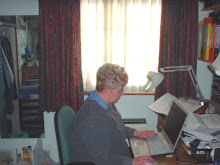I was born in Toronto and grew up there, attending schools and the local University of Toronto. But in my mid-twenties I left for England, married, settled down, raised a family, and eventually retired. I discovered family history around 1980 and have traced most of my own lines back to at least 1800. One line was living in the vicinity of Toronto even at that early date and another arrived around 1840. These two lines moved into Toronto itself in the 1890s and merged (married) in 1901. The other side of the family arrived from Scotland in late 1903.
My parents lived in Toronto all their lives and had a broad knowledge of the city—living, as one or the other of them did at different times, on the Island, in the “pan-handle” north of Lawrence but still in the city, near Broadview and Danforth, out near the Beaches, on Borden Street, ending up in a condo on the banks of the Humber, their one home outside Toronto proper. Even in her last years after she stopped driving at age 88, Mom could navigate anyone around any part of the city.
I joined a local family history society here in the UK in the early 80s and around the same time we bought our first computer. The two came together when the society decided to transcribe the local census. When the LDS decided to transcrbe the British census of 1881, I did quite a bit of work in my local county of Buckinghamshire and also in Scotland. My three times great grandfather had been census registrar in Rothesay on Bute in 1881. I had the privilege of transcribing out what he had put in.
Once on the internet with what we call a broadband connection and what North Americans call high-speed internet, I started investigating the online resources for Ontario, particularly the area around Toronto. I discovered Ontario GenWeb’s census project and its transcriptions of the 1851 and 1861 censuses of Markham, Vaughan and King townships. It wasn’t just viewing my great-great grandfather’s family in Markham Township that made it interesting, it was looking at all the families. I started to match those which I could find in both 1851 and 1861 censuses. I also found lists of marriages and tied those in too.
I knew we had a local Latter Day Saints Church with a Family History Centre where I could borrow microfilms and inspect them. It appeared that no one had ever attempted to transcribe the York Township census for 1851. Why not try it? So I did. In this case my original transcription was made on pre-designed forms and handwritten in pencil, leaning on a clipboard. The population in that year was just over 10,000.
The process turned out to be not the least bit boring. It was really great fun, especially when I was able to figure out where I was in relation to streets of today. There weren’t any clues to this other than there were two divisions—east and west of Yonge Street. All I could depend on was surnames that linked with later street names, a comment about the building of the original Woodbine racetrack, and railway construction sites. The eastern division stretched from Yonge to Victoria Park and mostly from Steeles Ave down to Bloor St, but east of the Don River, this extended to the lake front. The western division stretched from Yonge to the Humber River and from Steeles to Bloor St West. The accompanying agricultural census listed locations by landowners, and many were not residents.
The following year I transcribed the 1861 York Township census. The population had expanded to 11,500. Locating people was easier this time. There were now seven divisions—three pretty rural ones on each side of Yonge Street and Yorkville, a much more urban village on the edge of Toronto immediately north of Bloor Street. The 1861 agricultural census was more useful, and I did thank the enumerator of Divison Three who made it his business to trace the home address of every servant working in households in his patch.
Where are these transcriptions? Tucked away in my computer, waiting on someone to come along and offer to proofread. Now that the 1851 census is online, it has been transcribed again and is to be found on two different websites, but we must now wait for Ancestry to work through its recent acquisitions from Library and Archives Canada before the 1861 comes online.
Monday, 5 January 2009
Subscribe to:
Post Comments (Atom)




No comments:
Post a Comment